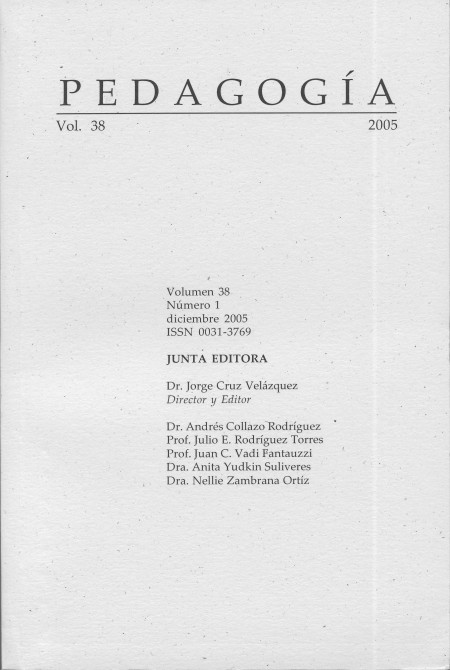Resumen
Cómo citar:
Torres-Lara, M. (2005). Las investigaciones sobre el cerebro y las emociones: Implicaciones educativas para la niñez temprana. Pedagogía, 38(1), 131-151.
Citas
Adolphs, R., Tranel, D. & Damasio, A. R. (2003). Dissociable neural systems for recognizing emotions. Brain and Cognition, 52(1), 61-69.
Álvarez, H. J. (2000). Aprendizaje y la memoria: Implicaciones de los descubrimientos de las neurociencias. El Sol, 44 (3), 4-9.
Álvarez, H. J. (2000). Las emociones y el aprendizaje. El Sol, 44 (3), 14-17.
Berk, L. & Winsler, A. (1995). Vygotsky's Theory in Early Childhood Classrooms. Scajfolding Children s Learning: Vygotsky and Early Childhood Education. Washington D. C.: NAEYC.
Berridge, K. C. (2003). Pleasures of the brain. Brain and Cognition, 52(1), 106-128.
Berthoz, S., Blair, R. J. R., LeClec'h, G., Martinot, J. (2002). Emotions: From neuropsychology to functional imaging. lnternational Journal of Psychology, 37 (4), 193-203.
Brandt, R. (1999). Educators Need to Know About the Human Brain. Phi Delta Kappan, 81 (3), 235-238.
Cintrón, C. (1999). El cerebro, la lectura y la literatura infantil: Realidades conexas. Al son de los tiempos (pp.123-146). Santo Domingo: Centenario.
DeVries, R. & Zan, B. (1995). Creating a Constructivist Classroom Atmosphere. Young Chi/dren, 51(1), 4-13.
Diamond, M. & Hopson, J. (1999). Magic Trees of the Mind: How to nurture your child's intelligence, creativity and healthy emotions from birth through adolescence. England: Plume, Penguin Books.
Eliot, L. (1999). What 's going on in there? How the Brain and Mind Develop in the First Five Years of Life. New York: Bantam Books.
Flaherty, T. (Ed.). (1993). Mind and Brain: Journey through the Mind and Body. New York: Time-Life Books.
Fogarty, R. (2002). Brain Research Base. Brain-Compatible Classrooms (2da ed., pp 1- 49) Illinois: SkyLight Professional Development.
Fogarty, R. (2002). Defining Brain-Compatible Classrooms. Brain-Compatible Classrooms (2da ed., pp 51- 76). lllinois: SkyLight Professional Development.
Fogarty, R. (2002). Setting the Climate for Thinking. Brain-Compatible Classrooms (2da ed., pp 77- 119). lllinois: SkyLight Professional Development.
Frost, J., Wortham, S. & Reifel, S. (2001 ). Play and Child Development. Ohio: Merrill Prentice Hall.
Gilkerson, L. (1998). Brain Care: Supporting Healthy Emotional Development. Brain Research: Beginnings Workshop, Child Care Information Exchange, 66-68.
Hagemann, D., Waldstein, S.R. & Thayer, J.F. (2003). Central and autonomic nervous system integration in emotion. Brain and Cognition, 52(1), 79.
Jensen, E. (1998). Teaching with the brain in mind. Virginia: Association for Supervision and Curriculum Development.
Kluger, J. & Park, A. (2001, 30 de abril). The Quest for a Super Kid. Time Magazine Archive. Recuperado el 21 de septiembre de 2003, http://time-proxy.yaga.co111/time/magazine/a11icle/qpass/01,0987,11OIO10430-107256,00.h
LeDoux, J. (2000). Emotion Circuits in the Brain. Annual Reviews Neuroscience, 23, 155-1.
Nash, M. (1997, 3 de febrero). Fertile Minds. Time Magazine Archive. Recuperado el 21 de septiembre de 2003 de http://timeproxy.yaga.com/time/magazine/article/qpass/0,10987,11OIO10430-107256,00.h
Panksepp, J., Burgdorf, J., Turner, C. & Gordon, N. (2003). Modeling ADHD-Type arousal with unilateral frontal cortex damage in rats and beneficial effects of play therapy. Brain and Cognition, 52(1), 97-105.
Patterson, D.W. & Schmidt, L.A. (2003). Neuroanatomy of the human affective system. Brain and Cognition, 52(1), 24-2.
Pérez-Edgar, K. & Fox, N.A. (2003). Individual differences in children's performance during an emotional Stroop task: A behavioral and electrophysiological study. Brain and Cognition, 52(1), 33-51.
Richburg, M. & Fletcher, T. (2002). Emotional intelligence: Directing a Child's Emotional Education. Child Study Journal, 32(1), 3 1-39.
Rodríguez Arocho, W. (1998). La perspectiva constructivista en la educación: Implicaciones y aplicaciones. Pedagogía, 32, 6-20.
Schiller, P. (1999). Start Smart: Building Brain Power in the Early Years. Maryland: Griphon House.
Schmidt, L. A., Trainor, L. J. & Santesso, D. L. (2003). Development of frontal electroencephalogram (EEG) and heart rate (ECG) responses to affective musical stimuli during the first 12 months of post-natal life. Brain and Cognition, 52(1), 27-32.
Schulkin, J., Thompson, B. L. & Rosen, J. B. (2003). Demythologizing the emotions: Adaptation, cognition and visceral representations of emotion in the nervous system. Brain and Cognition, 52(1), 15-
Shore, R. (1997). Rethinking the Brain: New Insights into Early Development. New York: Families and Work lnstitute.
Simpson, J. R., Ongur, D., Akbudak, E., Conturo, T. E., Ollinger, J. M., Zinder, A. Z., et. al. (2000). The Emotional Modulation of Cognitive Processing: An fMRI Study. Journal of Cognitive Neuroscience, 12 (6), 157-170.
Thomas, R. (2000). Comparing Theories of Child Development (5ta ed.). California: Wadsworth Thomson Learning.
Windmann, S. & Kutas, M (2001). Electrophysiological Correlates of Emotion-Induced Recognition. Journal of Cognitive Neuroscience, 13(5), 577-592.
Zhu, J. & Thagard, P. (2002). Emotion and Action. Philosophical Psychology, 15(1), 19-36.

Esta obra está bajo una licencia internacional Creative Commons Atribución-NoComercial 4.0.

